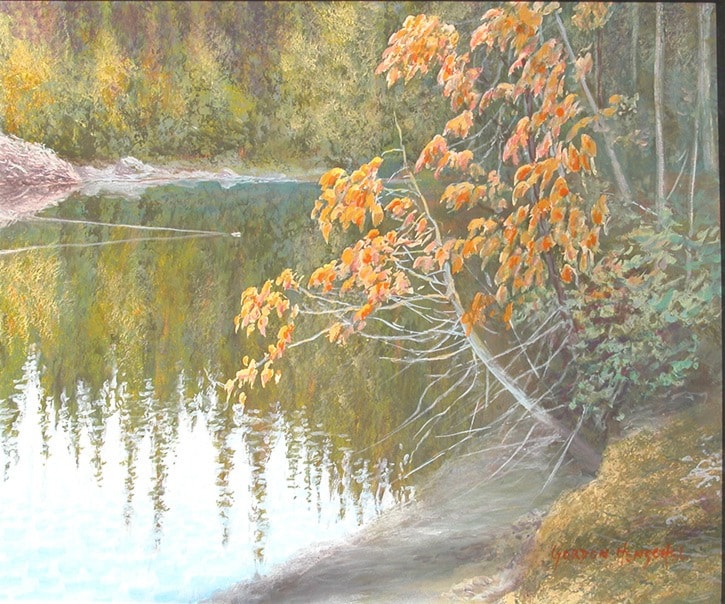It is early autumn in this painting and we can all identify with the vision of the little head ploughing its way through the quiet waters of a pond; a pond that has often been created by a family of beavers by damming up a creek. Were it not for its wake, it would likely go unnoticed, but don’t be fooled by the size of the tip of its head. This animal can be up to four feet long and weigh as much as a hundred pounds!
In the top left corner of the pond, a lodge made of sticks and mud is home sweet home. This lodge is built up near the bank of the pond, probably on a raised flat rock. Beavers are great carpenters and often choose rocks that are a little above the high water mark. Building on and around it, the top of the rock then becomes the floor of their living room and is covered with wood chips to absorb any moisture. There is a vent to let in fresh air as well as one or two entrances below water level.
The beaver in this painting is typical of the activity during the fall season. Since it doesn’t hibernate, it must lay by provisions for the winter in the form of various trees, small enough to handle. Because ice will cover the pond, these trees and their branches are pulled below the water and anchored as firmly as possible to the muddy bottom of the pond. They will eat the bark and cambium layer of most hardwood trees but draw the line at conifers! Their ability to gnaw down trees at an alarming rate enables them to store an immense amount of wood in a very short time, but they are highly overestimated in their tree-falling skills. Their accident rate is frightening. If you look at their working areas, I’m sure they have absolutely no idea where the tree is going to land, but they do get the job done quickly.
The beaver pond itself is usually situated where there is a good supply of hardwoods. These little engineers place their dams along a stream where there is such a supply, build it up until the water reaches a level near the trees enabling them to fall the trees into the water. When the trees along the edge of the pond have been harvested, they simply raise the dam. I once stood below a dam that was at least ten feet high with a pond covering almost a square kilometre! There’s an old story among hydro engineers that tells of a very extensive and, no doubt, expensive study done along one of Canada’s smaller rivers. When the final site was chosen, they found the beavers had already started a dam there!
Beavers mate for life with mating season running from January to March (those long winter nights). Gestation is about three months resulting in one litter of three or four kits in the spring of each year. With open eyes when they are born, they can swim within twenty-four hours, exploring their watery world around the lodge, accompanied by their parents, within a few days. They will remain with them for two years.
I love beavers! To me they are the epitome of wilderness and the ability of wild animals to be totally independent of man. They are not tempted by what we have to offer. Not a single beaver has been in my garbage or my garden, nor gnawed its way into my house! They are so silent in their work that, in painting beside beaver ponds, I am often unaware of their presence until I hear their tail slap a warning to their family. A silent and dignified Canadian, it was an astute move indeed to make it our emblem.
Gordon Henschel owns an art gallery in Nimpkish Heights. www.henschel.ca
